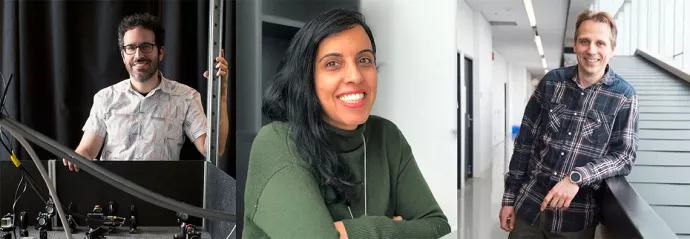
New Frontiers in Research Fund
Using microscopy to study how genes function is Professor Joshua Milstein’s particular area of expertise, and with a recent award of $250K from the New Frontiers in Research Fund (NFRF) he is going to be using those skills to focus on combatting bacterial persistence in Tuberculosis (TB), a contagious infection that is one of the top 10 causes of death worldwide.
“Over the years my lab has primarily focused on the molecular mechanisms of chronic infection and antibiotic resistance to study how harmless bacteria might suddenly turn on some genetic switch and either become deadly or morph into an infectious state,” says Milstein.
“With this new NFRF project, I am collaborating with UofT Professors Jon Rocheleau from the Institute of Biomedical Engineering and Jun Liu in Molecular Genetics. We are aiming to better understand the metabolic changes that occur in “persister” cells associated with TB in the hope of making the treatment of this infection more effective and, perhaps, one day eradicating TB entirely.”
Milstein explains that TB is an infection of the lungs and the typical treatment is an antibiotic cocktail that is prescribed to a patient for an extended length of time that could last up to six months or more.
The antibiotics might kill some of the bacteria, but he says that persister cells are a “subpopulation” of the infectious cells that are able to slow down in growth and activity, essentially hanging out while the antibiotic treatment is undertaken, and then randomly switch on once the antibiotics are gone, bringing the infection back with them.
Over the next two years for this project, a graduate student in Milstein’s lab will employ microscopy and microfluidics to study the activity of M. smegmatis cells, a non-infectious relative of the TB pathogen, and determine how changes in their metabolism help them survive. He explains that microfluidics is the process that allows their team to miniaturize the system, to effectively grow the cells in tiny petri dishes that are smaller than a pin head, yet provide an extremely well controlled environment in which to study them. Rocheleau’s team creates the genetically encoded biosensors that make the individual cells glow and allows Milstein’s lab to track and study metabolic changes inside the bacteria using computer software, and Liu brings his extensive expertise of TB to the project to help them better understand elements of the disease.
“TB is the canonical example where cells use this survival strategy, and so understanding and combatting the persister cells in this infection is ultimately the key,” says Milstein.
“If you can figure out what genes are turning on that make them go into this inert metabolic state, maybe there are ways then to target this strange persister-cell population specifically so that the person suffering from TB will eventually be spared from taking these huge and extended regimes of antibiotics.”
- Hear more from Professor Milstein about his "Adventures in Research" on the October 2020 episode of VIEW to the U podcast.
Professors Cosmin Munteanu and Negin Dahya in UTM’s Institute of Communication, Culture, Information and Technology (ICCIT) were also successful with their NFRF Exploration grant. They were awarded over $247K for their project, “Resilience at the crossroads: a techno-feminist approach to intergenerational culture preservation through social storytelling and sense-making within displaced populations.”
“Cultural identity and resilience are often preserved across generations through social practices, such as grandparents telling stories and imparting cultural knowledge to their grandchildren, however these practices are disrupted during crisis or economic migration and resettlement,” say Munteanu and Dahya.
“This upheaval can in turn create significant barriers for older generations who help shape a sense of identity for younger family members, while at the same time they themselves are adapting to a new culture and facing challenges.”
There are currently support tools in place to enable this kind of cultural preservation activity, such as digital tools to record stories, however after closer consideration they are often imbued with colonial values and compromised by technical limitations.
Munteanu, Dahya and their team, which also includes Professor Ishtiaque Ahmed from UofT’s Department of Computer Science, aim to better understand how cultural resilience is reinforced through storytelling and also more closely examine the lack of support during and after migration. Their transdisciplinary approach draws on three areas, critical theory, human-computer interaction (HCI), and sociology of technology, and the research team expects to define strategies to help migrants develop and establish their cultural identity.
“With Negin’s expertise in critical feminist theory, digital media production and migration, Ishtiaque’s work in computing technology and marginalized population, and my own research in HCI and cross-generational connections, we expect our findings to make significant scholarly impact and social contributions,” says Munteanu.
- Find out more about Professor Dahya's work: she was featured earlier this year on VIEW to the U podcast (March 2020) talking about Technological Tools for Education & Connection.
Launched under the fund’s Exploration stream, the NFRF competition provides grants of up to $125,000 per annum for two years for teams of two or more researchers. The objective of the Exploration stream is to foster and support world-leading discovery and innovation by encouraging Canadian researchers to explore, take risks, lead, and work with partners across disciplines and borders, with the capacity to explore something new that might fail but has the potential for significant impact. This last NFRF round culminated with $46.3 million awarded to support 186 research projects across Canada.
See the full list of recipients from the 2019 competition on the NFRF website.
